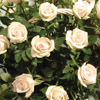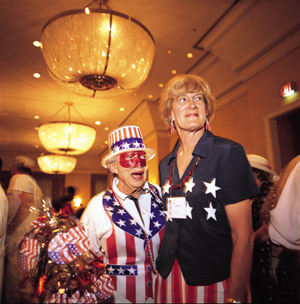 |
|
|||||||||
|
>> continued... Her energy assessment seems accurate. After staying up until 3 a.m. to prepare her arrangements, by 10 a.m. Friday morning Jones, in a salmon blouse and light pink slacks, is checking out the Merchandise Marketplace, where merchants sell rose jewelry, rose stationery, rose hand lotion, rose slippers, gardening gloves, fertilizer, garden sprayers, roses by the bunch, and rose bushes. The customers are mostly older, heterosexual couples—burly male gardener/farmer types and their solid, demure wives—or gay couples. Women wear rose-printed tops, pants, scarves, shoes, or hats. An excited group in the corner checks out an Oregon hybrider’s newest roses—one bush with large, full, light-pink blooms he’s named Ground Zero and another with similarly lush, hot-pink blooms called Nine Eleven.
Jones decides not to buy any “kitsch” in the marketplace. She leaves to lunch at the hotel café with some ARS friends. Their discussion about roses, health, and love—including Jones’s three marriages, two to fellow Chicago alumni—lasts two hours, and they miss the afternoon seminar on Josephine Bonaparte, who collected roses with the same passion that Napoleon collected countries. After lunch Jones finds Lew Schute, the national chair for rose-arrangements judges, who has promised to come to Jones’s room to critique her arrangements. The gray-haired but youthful Schute looks at the breakfast tray. “I like the color,” he purrs. “What if we put the cup on its side?” He leans the teacup sideways on its saucer. “Oh, I like that,” Jones says. Schute admires the “Voodoo” candle holder, but it needs more height, he says. “Do you have a platform to put it on?” The two construct a platform out of two black trays from the bathroom—the ones that had held the hotel’s coffee pot and mugs—and two cylindrical containers of floral foam. Schute’s visit increases Jones’s excitement about the show. She skips the evening’s entertainment, a Mississippi River dinner cruise on a paddlewheel boat, to tweak the arrangements and open her rose box. She’s learned that she can get into the exhibition room tonight and won’t have to wake up at 4 a.m. to prepare her roses before the 8:30 judges’ breakfast—she’s evaluating horticulture—and the 9 a.m. judging. A hotel security guard unlocks the cold-storage room. “It’s not very cold in here,” Jones says. “It should be 34 degrees.” The room’s thermostat reads 64. She inspects a group of tall, unboxed roses, with red, pink, white, and yellow blooms wrapped in plastic baggies. “These are shot,” she says. “See how their outside petals are sagging? Whoever belongs to these roses is going to be pissed.” She points to large picnic coolers along the wall. “Those will probably be all right.” Finding her own cardboard box, she says, “Let’s see if any of mine survived.” If she has one perfect rose, she’s decided, she’ll enter it in the judges’ horticulture class. A bellhop lifts her box onto a luggage carrier and wheels it to her room. Jones turns to the duct-taped package, stabbing at it with her shears and a Swiss Army knife before finally slicing it open. After pulling out the blue ice packs one by one, she raises the Lucite covering and picks up the Nicoles. The blooms are slightly smashed but still full of petals, and she places the stems in cold water in a hotel ice bucket. She reaches deep into the box and lifts the Styrofoam base with the rest of her roses. As the blooms rise, an immense shower of petals—light pink, magenta, white, red, yellow—falls to the floor. Jones’s face sinks too when she sees the mangled stems and blooms that remain. Then she shrugs. “As the French say, ‘C’est bien dommage.’” From the Styrofoam she pulls a test tube holding a short stem with a dented but full peach and yellow bloom. “This Polka might be all right,” she says, removing the test tube and placing the stem in a Sheraton coffee mug filled with ice water. Four or five more Polkas join the first. A few white Crystalline also are salvaged, along with some white Pillow Fight, a filler shrub. But as she pops most of the test tubes from the base, more petals fall. There is no perfect rose, and there are too few to complete the ten arrangements. “I shouldn’t have tried to fit so many in the box,” Jones says. “And I really shouldn’t have put the Nicoles on top. Oh well, live and learn.” She reaches to the floor and grabs two large handfuls of petals, which would look lovely scattered on a wedding aisle but do her little good now. She brushes the petals to her face and kisses them. “I love the way they feel,” she says, “like a baby’s skin.” After tossing the petals into the garbage, the mourning is over. Jones places an 11 p.m. room-to-room phone call to Lynn Snetsinger, an exhibitor friend. “Oh, you need shears?” Jones says into the receiver. “Well, I’ll make you a trade. Do you have any roses I can use?” By the time Jones finishes snaking roses from sympathizers, brushing the petals with panty hose to bring out their natural sheen, and fitting the flowers into seven arrangements, it’s 7:35 Saturday morning. The only blooms of her own to survive the night are the Nicoles for the stretch design and a Crystalline, a Pillow Fight, and a miniature, the three of which she fits into the sake container on her breakfast tray. She changes into her black judging skirt at 8 and by 8:30 is at breakfast. At 9 the judging begins. She joins her team of two other judges and two clerks, who will put ribbons on winning roses and pluck the top performers for the next round. She and her team tour the contestant tables, silently jot their favorites on a piece of paper, and hand them to the judge chair. Their picks join the other teams,’ and the process continues until they’ve whittled down a winner in each category. By 1 p.m. it’s over. Although Jones’s arrangements win some second-place, third-place, and honorable-mention ribbons, she considers her performance a continuation of her losing streak, which stings a bit harder because it’s a national show. Strolling around the trophy table she sees that Lynn Snetsinger has won a half-dozen trophies—as has another exhibitor whom Jones and other participants gossip about as a show-off. Returning to her arrangements, she reads the judges’ comments, which frustrate her. On “Voodoo,” which won third prize: “Color combination of red and black incorporated theme!” But “base overpowers design.” Well, she notes, Lew Schute had helped create the base. On “Throw Me Something Mister,” which received no prize: “Didn’t conform to requirement of stretch design.” She has no idea why not. Later, when she’s had time not to sleep but at least to order a bowl of chicken soup in the hotel lounge, she considers the psychology of her loss. “Whenever someone isn’t realizing their dreams it’s because they’re holding onto some old negative thought they’re afraid of,” she says. Perhaps, Jones conjectures, if she won as many trophies as the gossiped-about winner, she’s afraid that people would dislike her too. After the soup, Jones heads back to her room to dress for the “Come as a Rose” costume banquet. She reemerges smiling behind a red glitter mask and red, white, and blue top hat and vest. She waves a wand of silver foil stars. “I’m Stars and Stripes!” she says, a miniature rose variety. An elderly man wears his old Army uniform, dressed as the rose called Veteran’s Honor. A couple wearing pajamas hit each other with small white pillows—they’re Pillow Fight. A man in boxer shorts, a white robe, and boxing gloves is a Knockout rose. With varieties like Tropicana, Swamp, Tiger Tail, Fairy, Baby Blanket, Chili Pepper, Butterfly Kisses, Black Magic, Carrot Top, and Pink Poodle, the revelers may as well be at a Halloween party. At 10 p.m. Jones retreats to her room for a bath and a good night’s sleep. Tomorrow there are more seminars and an awards dinner, and Monday she’ll head to Shreveport to tour the American Rose Center’s gardens. On Tuesday she’ll fly home, tend her bushes, and prepare for the rest of the six-week spring showing season. For the fall national show in Washington, D.C., and next year’s spring national show in San Diego, she says, she’ll ship her roses UPS rather than bring them on the plane. And she won’t toss extras on top.
|
|
Contact
|

 Tournament
of Roses
Tournament
of Roses